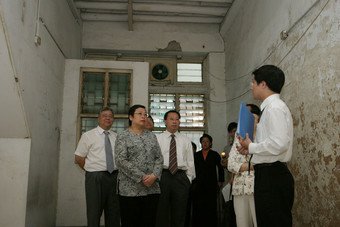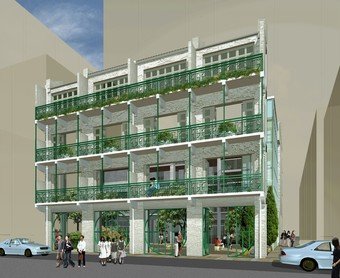


Community starts work on URA revitalisation project
A newly formed committee between the Urban Renewal Authority
(URA) and the Wan Chai local community starts work today (Monday)
on planning a $100 million revitalisation project in fostering Hong
Kong's creative and cultural industries.
Subject to the Town Planning Board's approval, the URA intends to
preserve a row of six pre-war "shop-houses" in Mallory Street, Wan
Chai and refurbish them as a haven for various operators in
creative and cultural industries.
"This is such a new and unprecedented attempt that we think it
very important to widely consult the local community as well as the
prospective operators before we decide on the mix of industries,
architecture design and mode of self-supporting operational
management," said Ms Maria Tam, URA Board member and Chairperson of
the URA's Wan Chai District Advisory Committee (DAC).
The DAC has therefore set up a special committee for the project
and invited the Wan Chai District Council and District Office to
join in. Chaired by Ms Tam, the committee comprises DAC members Mr
Mak Chi-cheung and Mrs Fanny Lai; Wan Chai District Council's
Chairperson Ms Ada Wong and members Mr Steve Chan, Ms King Pui-wai
and Ms Tang King-yung; Wan Chai District Officer Ms Pauline Wong
and URA officials.
In deliberating the way forward for the project, an important part
of the committee's task is to collect and collate views and
suggestions from other segments of the community, particularly
operators in creative and cultural industries.
The project is inspired by the Government's 2005 Policy Address
that highlights "the importance of rejuvenating old districts in
cities to create a cultural atmosphere, thereby attracting talents,
fostering cultural and creative industries and developing local
community economy." The Policy Address says that creative
industries in Hong Kong encompass 11 categories: design,
architecture, performing arts, publishing, music, film, computer
software, digital entertainment, performing arts, broadcasting, and
antiques and art dealing.
"Mallory Street is a trial project that will provide about 20
units of space totaling about 18,300 square feet. Obviously, there
is a limit to the number of operators it can accommodate and hence
the importance of a judicious selection of future users," Ms Tam
said.
The committee members carried out an on-site inspection of the
pre-war architecture before holding its first meeting today.
During the meeting, the committee endorsed the terms of reference
which included making recommendations on the direction, strategy
and specific objectives for implementing the project, the measures
to be taken by the URA in consulting the stakeholders, the layout
and physical design as well as the detailed business plan for
achieving financial self-sufficiency in day-to-day operation. The
committee also agreed that wide public consultation was essential
and the first stage should begin with inviting ideas and proposals
from the 11 categories of cultural and creative industries.
Occupying a ground area of about 8,400 square feet, the project
site currently has 10 four-storey "shop-houses" believed to be
built in the 1920's. Some are in a very dilapidated condition
without even basic sanitary facilities. The URA's initial plan is
to retain and refurbish six of them, which are in a relatively
better condition, to provide 20 or more partitioned units with a
total floor area of 18,300 square feet. The remaining four
buildings will be demolished to make way for a 3,000-square foot
landscaped open space for public enjoyment. But if structure
engineering permits, the façade of the four to-be-demolished
buildings will also be preserved.
Commenting on the site, Ms Tam said it provided a rare opportunity
for attracting creative talents to operate in an architectural
setting with distinctive character and also the benefit of a
convenient location.
She said the project was part and parcel of the URA's 4R approach
- Redevelopment, Rehabilitation, Revitalisation and pReservation -
for integrated, long-term urban renewal in the Wan Chai
district.
Of the $100 million development cost, about $62 million is
estimated for acquisition and rehousing. It is targeted that the
project will be self-supporting in day-to-day operation. If
everything goes well, the URA hopes to complete the project by
2007.
